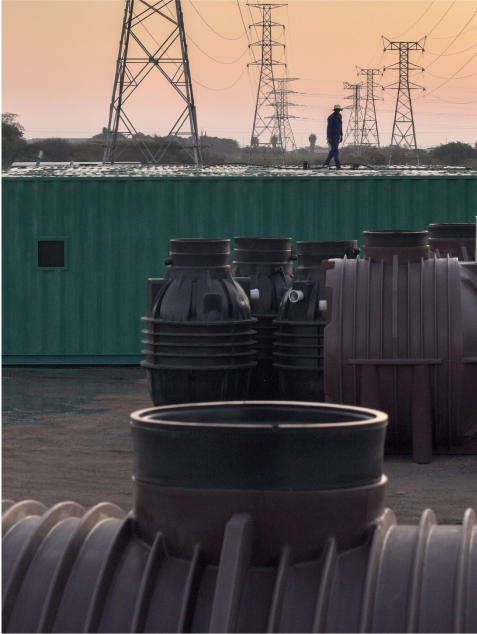In the face of increasingly pressing environmental challenges, sustainability has become more than just a buzzword – it’s a necessity. For countries like South Africa, where water scarcity is a serious concern, sustainable water management strategies have taken on added significance. One such strategy that has been receiving growing attention is the reuse of greywater.
The Growing Importance of Sustainable Water Management
Water is undeniably one of our most precious resources. However, it’s also one of the most misused. With the global population continuing to rise, the strain on our water resources is growing. This strain is further exacerbated in regions where water scarcity is already an issue.
In this context, sustainable water management – the careful stewardship and efficient use of water resources – is of paramount importance. It’s not just about conservation for conservation’s sake, but about ensuring that we have enough water to meet our current needs, without compromising the ability of future generations to meet their own.
The Benefits of Greywater Recycling
One key strategy in sustainable water management is the reuse of greywater. Greywater refers to the relatively clean wastewater that comes from baths, showers, washing machines, and sinks. Unlike blackwater, which comes from toilets and contains faecal matter, greywater is generally safe to reuse for purposes such as garden irrigation and toilet flushing, provided it is properly treated. (More on that later.)
Recycling greywater not only reduces overall water consumption, but it can also significantly decrease the amount of wastewater entering our sewers or septic systems. This can lead to lower water bills, reduced strain on municipal wastewater systems, and less pollution of our waterways. For more information on the benefits and process of greywater recycling, please visit our greywater solutions page.
In the following sections, we’ll delve into the specific strategies and considerations for optimising greywater systems for efficient reuse, including understanding the 24-hour rule for greywater storage, determining the right greywater storage tank size, the pros and cons of different tank installations, and the importance of maintaining your greywater system.
The 24-Hour Rule for Storage of Greywater
When it comes to managing greywater for reuse, one of the most important rules to understand is the 24-hour rule. Essentially, this rule states that greywater should not be stored for (you guessed it!) more than 24 hours.
The Dangers of Storing Greywater for Extended Periods
Storing greywater for extended periods can lead to a number of problems. First and foremost, it can significantly degrade the quality of the greywater. Unlike fresh water, greywater contains nutrients and organic matter from soaps and dirt. As these start to decompose, they use up the oxygen in the water, leading to the growth of harmful bacteria and a foul odour.
The longer greywater is stored, the greater the risk of it becoming blackwater. This is due to the fact that the bacteria present in greywater can multiply and create harmful pathogens if the water is not used within a short period of time.
Maintaining Greywater Quality Through Proper Storage
In light of this, it’s crucial to manage and store greywater properly to ensure its safe reuse. The primary way to do this is by following the 24-hour rule and designing your greywater system to use or release the greywater into the soil within a day of it being produced.
Proper greywater storage is also essential to avoid pooling of water which can lead to mosquito breeding and other hygiene issues. Therefore, your greywater storage tank should be designed and installed in a way that allows for efficient use or release of the stored greywater within the 24-hour period.
It’s also important to remember that different sources of greywater have different levels of contaminants. For example, greywater from your washing machine may have higher levels of detergents and chemicals compared to that from your shower. Therefore, consider the source of your greywater when planning your reuse applications.
In the next section, we’ll dive deeper into the specifics of determining the right greywater storage tank size for your needs. Remember, efficient greywater recycling doesn’t just benefit you – it contributes to the health of our planet as a whole.
Determining the Right Greywater Storage Tank Size
Choosing the correct size for your greywater storage tank is an essential step in establishing an efficient and practical greywater system. As a first step, you’ll need to understand how much greywater your household generates daily. This will largely depend on the size of your household and your daily water usage.
The majority of households consume approximately 150-200 litres of water per person per day, which can amount to 400-600 litres per day per household. Approximately 60% of this total water consumption can potentially be reused as greywater.
To give a practical example, a family of four might generate up to 360 litres of greywater per day (based on 150 litres per person per day and 60% of this being potentially reusable as greywater). If they plan to use this for toilet flushing, irrigation, and laundry, a tank of around 400 litres might be appropriate, providing some leeway for fluctuations in water use.
Separating Blackwater and Greywater
It’s crucial to distinguish between blackwater and greywater as they differ in their composition and treatment requirements. Blackwater is derived from toilets and kitchen sinks and contains food waste, grease, and faecal matter. This type of wastewater has high levels of harmful bacteria and pathogens, requiring thorough treatment before it can be safely reused.
On the other hand, greywater originates from sources such as showers, baths, washing machines, and bathroom sinks. Although it also contains some contaminants (like soap residues, skin cells, and hair), it’s generally safer and easier to treat for non-potable reuse than blackwater. A well-designed plumbing system should separate these two types of wastewater at the source, diverting greywater to a dedicated storage tank for subsequent treatment and reuse.
Accommodating 24-hour Greywater Production Volume
It’s important to choose a greywater storage tank that can accommodate your household’s daily greywater production volume. If your tank is too small, it won’t store all the greywater you generate in a day, leading to waste. Conversely, if your tank is too large, it can encourage storing greywater beyond the recommended 24-hour period, which can cause odour issues and bacterial growth.
Above-Ground vs. Underground Tanks
Pros and Cons of Each Installation Option
Both above-ground and underground tanks have their unique advantages and potential drawbacks.
Above-Ground Tanks:
Pros:
- Easier and less costly to install
- Simple to access for maintenance and inspections
- Visible water level, making it easy to monitor water usage
Cons:
- Can take up significant space in your garden or property
- May detract from the aesthetics of your outdoor area
- Potential risk of damage from external elements
Underground Tanks:
Pros:
- Space-saving solution that doesn’t interfere with your outdoor area
- Aesthetically pleasing as it’s hidden from sight
- Protects the tank from external damage
Cons:
- More complex and costly installation process
- More difficult to access for maintenance and inspections
- Requires careful planning to prevent groundwater intrusion and to ensure structural stability.
Maintaining Your Greywater System
Regular maintenance of your greywater system will ensure its long-term functionality and efficiency. This involves inspecting the system for any mechanical issues, cleaning or replacing filters as required, and checking the quality of the greywater regularly.
Remember that greywater should be properly treated before reuse. Depending on your system, this could involve filtration, chemical treatment, or even biological treatment processes to remove contaminants and pathogens.
Remember, well-maintained greywater systems not only last longer, but they also operate more efficiently and provide safer water for reuse. With proper care, your greywater system will serve as a valuable asset in your household’s sustainable water management practices for years to come.
Greywater Treatment: A Key Component of Sustainable Reuse
One of the crucial elements of utilising greywater systems effectively lies in the proper treatment of the stored water. Greywater treatment can be categorised into three main types: biological, chemical, and physical processes.
- Biological Treatment
This type of treatment takes advantage of the natural processes carried out by microorganisms to degrade and remove organic matter, pathogens, and some chemicals from the greywater. It’s often an environmentally friendly option and can include techniques such as constructed wetlands or the use of specialised bacteria in a bioreactor.
- Chemical Treatment
Chemical treatments typically involve the use of disinfectants such as chlorine, ozone, or ultraviolet light to kill bacteria and other pathogens. This method can be highly effective in ensuring the water is safe for certain reuse applications, but it’s important to manage and monitor the chemical usage to avoid potential environmental harm.
- Physical Treatment
Physical treatments include methods such as filtration and sedimentation, which can remove solids and some types of bacteria. Filtration systems can range from simple physical barriers to more complex processes like reverse osmosis. It’s a common practice to use physical treatment in combination with biological or chemical methods for a more thorough greywater treatment.
A well-designed greywater system will integrate appropriate treatment processes based on the source of the greywater and its intended reuse application. Not only does this safeguard the health and wellbeing of those using the water, but it also helps to ensure the longevity of the system by preventing blockages or damage caused by untreated waste.
In Conclusion
Greywater reuse embodies the essence of sustainable living, promoting a lifestyle that seeks to reduce wastage and recycle valuable resources. By integrating a well-optimised greywater system into our households, we each contribute meaningfully to water conservation efforts and environmental protection.
By reusing greywater, we essentially create a secondary water supply that can cater to various non-potable needs within our households, from flushing toilets to irrigating gardens. This not only reduces our reliance on municipal water supply but also leads to significant cost savings in the long run. Greywater recycling is a prime example of how practical sustainability can go hand in hand with economic sensibility.
As we face a future that is likely to be characterised by increased water scarcity due to climate change and population growth, innovative solutions such as greywater reuse become even more crucial. Greywater systems represent a significant stride towards the goal of achieving water security and sustainability.
At Calcamite, we’re proud to be a part of this journey towards a more sustainable and resilient water future for South Africa. We invite you to explore our greywater solutions, underground modular tanks, and our diverse range of greywater systems. Together, we can make a difference, one drop at a time!
Find out more about our: Greywater solutions, Underground modular tanks & Greywater systems



